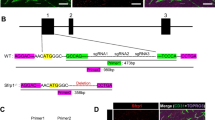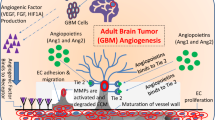Abstract
The study was aimed at determining the vascular expression of oncofetal fibronectin (oncfFn) and tenascin-C (oncfTn-C) isoforms in renal cell carcinoma (RCC) and its metastases which are well-known targets for antibody-based pharmacodelivery. Furthermore, the influence of tumour cells on endothelial mRNA expression of these molecules was investigated. Evaluation of vascular ED-A+ and ED-B+ Fn as well as A1+ and C+ Tn-C was performed after immunofluorescence double and triple staining using human recombinant antibodies on clear cell, papillary and chromophobe primary RCC and metastases. The influence of hypoxic RCC-conditioned medium on oncfFn and oncfTn-C mRNA expression was examined in human umbilical vein endothelial cells (HUVEC) by real time RT-PCR. There are RCC subtype specific expression profiles of vascular oncfFn and oncfTn-C and corresponding patterns when comparing primary tumours and metastases. Within one tumour, there are different vessel populations with regard to the incorporation of oncfTn-C and oncfFn into the vessel wall. In vitro tumour-derived soluble mediators induce an up regulation of oncfTn-C and oncfFn mRNA in HUVEC which can be blocked by Avastin®. Vascular expression of oncFn and oncTn-C variants depends on RCC subtype and may reflect an individual tumour stroma interaction or different stages of vessel development. Therefore, oncFn or oncTn-C variants can be suggested as molecular targets for individualized antibody based therapy strategies in RCC. Tumour-derived VEGF could be shown to regulate target expression.






Similar content being viewed by others
References
Astrof S, Hynes RO (2009) Fibronectins in vascular morphogenesis. Angiogenesis 12:165–175
Balamurugan K, Luu VD, Kaufmann MR, Hofmann VS, Boysen G, Barth S, Bordoli MR, Stiehl DP, Moch H, Schraml P, Wenger RH, Camenisch G (2009) Onconeuronal cerebellar degeneration-related antigen, Cdr2, is strongly expressed in papillary renal cell carcinoma and leads to attenuated hypoxic response. Oncog ene. 28:3274–3285
Ballard VL, Sharma A, Duignan I, Holm JM, Chin A, Choi R, Hajjar KA, Wong SC, Edelberg JM (2006) Vascular tenascin-C regulates cardiac endothelial phenotype and neovascularization. FASEB J 20:717–719
Berndt A, Anger K, Richter P, Borsi L, Brack S, Silacci M, Franz M, Wunderlich H, Gajda M, Zardi L, Neri D, Kosmehl H (2006) Differential expression of tenascin-C splicing domains in urothelial carcinomas of the urinary bladder. J Cancer Res Clin Oncol 132:537–546
Berndt A, Köllner R, Richter P, Franz M, Voigt A, Berndt A, Borsi L, Giavazzi R, Neri D, Kosmehl H (2010) A comparative analysis of oncofetal fibronectin and tenascin-C incorporation in tumour vessels using human recombinant SIP format antibodies. Histochem Cell Biol 133:467–475
Borsi L, Carnemolla B, Nicolò G, Spina B, Tanara G, Zardi L (1992) Expression of different tenascin isoforms in normal, hyperplastic and neoplastic human breast tissues. Int J Cancer 52:688–692
Brack SS, Silacci M, Birchler M, Neri D (2006) Tumor-targeting properties of novel antibodies specific to the large isoform of tenascin-C. Clin Cancer Res 12:3200–3208
Brauch H, Weirich G, Brieger J, Glavac D, Rödl H, Eichinger M, Feurer M, Weidt E, Puranakanitstha C, Neuhaus C, Pomer S, Brenner W, Schirmacher P, Störkel S, Rotter M, Masera A, Gugeler N, Decker HJ (2000) VHL alterations in human clear cell renal cell carcinoma: association with advanced tumor stage and a novel hot spot mutation. Cancer Res 60:1942–1948
Carnemolla B, Borsi L, Balza E, Castellani P, Meazza R, Berndt A, Ferrini S, Kosmehl H, Neri D, Zardi L (2002) Enhancement of the antitumor properties of interleukin-2 by its targeted delivery to the tumor blood vessel extracellular matrix. Blood 99:1659–1665
Coltrini D, Ronca R, Belleri M, Zardi L, Indraccolo S, Scarlato V, Giavazzi R, Presta M (2009) Impact of VEGF-dependent tumour micro-environment on EDB fibronectin expression by subcutaneous human tumour xenografts in nude mice. J Pathol 219:455–462
Eble JA, Niland S (2009) The extracellular matrix of blood vessels. Curr Pharm Des 15:1385–1400
Frey K, Schliemann C, Schwager K, Giavazzi R, Johannsen M, Neri D (2010) The immunocytokine F8-IL2 improves the therapeutic performance of sunitinib in a mouse model of renal cell carcinoma. J Urol 184:2540–2548
Giannelli G, Bergamini C, Fransvea E, Sgarra C, Antonaci S (2005) Laminin-5 with transforming growth factor-beta1 induces epithelial to mesenchymal transition in hepatocellular carcinoma. Gastroenterology 129:1375–1383
Heller R, Unbehaun A, Schellenberg B, Mayer B, Werner-Felmayer G, Werner ER (2001) l-ascorbic acid potentiates endothelial nitric oxide synthesis via a chemical stabilization of tetrahydrobiopterin. J Biol Chem 276:40–47
Hindermann W, Berndt A, Borsi L, Luo X, Hyckel P, Katenkamp D, Kosmehl H (1999) Synthesis and protein distribution of the unspliced large tenascin-C isoform in oral squamous cell carcinoma. J Pathol 189:475–480
Johannsen M, Spitaleri G, Curigliano G, Roigas J, Weikert S, Kempkensteffen C, Roemer A, Kloeters C, Rogalla P, Pecher G, Miller K, Berndt A, Kosmehl H, Trachsel E, Kaspar M, Lovato V, González-Iglesias R, Giovannoni L, Menssen HD, Neri D, de Braud F (2010) The tumour-targeting human L19-IL2 immunocytokine: preclinical safety studies, phase I clinical trial in patients with solid tumours and expansion into patients with advanced renal cell carcinoma. Eur J Cancer 46:2926–2935
Mårlind J, Kaspar M, Trachsel E, Sommavilla R, Hindle S, Bacci C, Giovannoni L, Neri D (2008) Antibody-mediated delivery of interleukin-2 to the stroma of breast cancer strongly enhances the potency of chemotherapy. Clin Cancer Res 14:6515–6524
Mighell AJ, Thompson J, Hume WJ, Markham AF, Robinson PA (1997) RT-PCR investigation of fibronectin mRNA isoforms in malignant, normal and reactive oral mucosa. Oral Oncol 33:155–162
Naito S, von Eschenbach AC, Giavazzi R, Fidler IJ (1986) Growth and metastasis of tumor cells isolated from a human renal cell carcinoma implanted into different organs of nude mice. Cancer Res 46:4109–4115
Neri D, Bicknell R (2005) Tumour vascular targeting. Nat Rev Cancer 5:436–446
Orend G, Chiquet-Ehrismann R (2006) Tenascin-C induced signaling in cancer. Cancer Lett 244:143–163
Pedretti M, Verpelli C, Mårlind J, Bertani G, Sala C, Neri D, Bello L (2010) Combination of temozolomide with immunocytokine F16-IL2 for the treatment of glioblastoma. Br J Cancer 103:827–836
Saharinen P, Bry M, Alitalo K (2010) How do angiopoietins Tie in with vascular endothelial growth factors? Curr Opin Hematol 17:198–205
Saito Y, Shiota Y, Nishisaka M, Owaki T, Shimamura M, Fukai F (2008) Inhibition of angiogenesis by a tenascin-C peptide which is capable of activating beta1-integrins. Biol Pharm Bull 31:1003–1007
Santimaria M, Moscatelli G, Viale GL, Giovannoni L, Neri G, Viti F, Leprini A, Borsi L, Castellani P, Zardi L, Neri D, Riva P (2003) Immunoscintigraphic detection of the ED-B domain of fibronectin, a marker of angiogenesis, in patients with cancer. Clin Cancer Res 9:571–579
Schenk S, Chiquet-Ehrismann R, Battegay EJ (1999) The fibrinogen globe of tenascin-C promotes basic fibroblast growth factor-induced endothelial cell elongation. Mol Biol Cell 10:2933–2943
Schliemann C, Neri D (2010) Antibody-based vascular tumor targeting. Recent Results Cancer Res 180:201–216
Schwarzbauer JE (1991) Alternative splicing of fibronectin: three variants, three functions. Bioessays 13:527–533
Shinojima T, Oya M, Takayanagi A, Mizuno R, Shimizu N, Murai M (2007) Renal cancer cells lacking hypoxia inducible factor (HIF)-1alpha expression maintain vascular endothelial growth factor expression through HIF-2alpha. Carcinogenesis 28:529–536
Silacci M, Brack SS, Späth N, Buck A, Hillinger S, Arni S, Weder W, Zardi L, Neri D (2006) Human monoclonal antibodies to domain C of tenascin-C selectively target solid tumors in vivo. Protein Eng Des Sel 19:471–478
Tong AL, Zeng ZP, Li HZ, Yang D, Lu L, Li M, Zhou YR, Zhang J, Chen S, Liang W (2006) von Hippel-Lindau gene mutation in non-syndromic familial pheochromocytomas. Ann N Y Acad Sci 1073:203–207
Villa A, Trachsel E, Kaspar M, Schliemann C, Sommavilla R, Rybak JN, Rösli C, Borsi L, Neri D (2008) A high-affinity human monoclonal antibody specific to the alternatively spliced EDA domain of fibronectin efficiently targets tumor neo-vasculature in vivo. Int J Cancer 122:2405–2413
von Lukowicz T, Silacci M, Wyss MT, Trachsel E, Lohmann C, Buck A, Lüscher TF, Neri D, Matter CM (2007) Human antibody against C domain of tenascin-C visualizes murine atherosclerotic plaques ex vivo. J Nucl Med 48:582–587
Zagzag D, Shiff B, Jallo GI, Greco MA, Blanco C, Cohen H, Hukin J, Allen JC, Friedlander DR (2002) Tenascin-C promotes microvascular cell migration and phosphorylation of focal adhesion kinase. Cancer Res 62:2660–2668
Zhou X, Rowe RG, Hiraoka N, George JP, Wirtz D, Mosher DF, Virtanen I, Chernousov MA, Weiss SJ (2008) Fibronectin fibrillogenesis regulates three-dimensional neovessel formation. Genes Dev 22:1231–1243
Acknowledgments
The authors are grateful to Claudia Seliger, Beate Ziegenhardt, Valentina Scarlato and Elke Teuscher for excellent technical assistance. The research leading to the results has received funding from the European Community’s Seventh Framework Programme (FP7/2007-2013) under grant agreement no Health-F2-2008-201342 (ADAMANT).
Conflict of interest
Dario Neri is a co-founder and shareholder of Philogen, the company which owns the rights over the F8, L19, F16 and G11 antibodies.
Author information
Authors and Affiliations
Corresponding author
Additional information
K. Galler and K. Junker contributed equally to the study.
Rights and permissions
About this article
Cite this article
Galler, K., Junker, K., Franz, M. et al. Differential vascular expression and regulation of oncofetal tenascin-C and fibronectin variants in renal cell carcinoma (RCC): implications for an individualized angiogenesis-related targeted drug delivery. Histochem Cell Biol 137, 195–204 (2012). https://doi.org/10.1007/s00418-011-0886-z
Accepted:
Published:
Issue Date:
DOI: https://doi.org/10.1007/s00418-011-0886-z




